Choosing the Best Silent Bathroom Fan: Expert Guidance
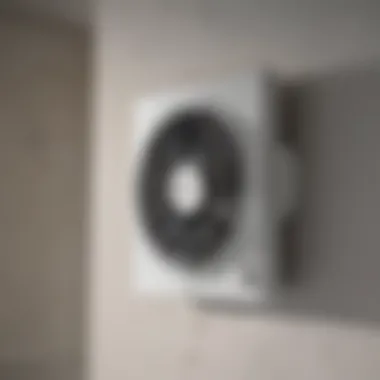

Intro
In today's modern bathrooms, having a functional ventilation system is essential for maintaining air quality and comfort. Choosing the best silent bathroom fan might not seem like a critical task for some, but the right decision can significantly enhance the atmosphere of your space. A silent fan not only eliminates excessive noise but also aids in preventing mold, reducing humidity levels, and ensuring a fresh environment.
Whether you're upgrading an old unit or installing one for the first time, understanding the nuances involved welcomes a more satisfying choice. Factors such as noise levels, energy efficiency, and performance come into play as you navigate through options available in the market.
This guide aims to offer comprehensive insights to house owners and homemakers alike while simplifying the decision-making process in your endeavor to enrich your bathroom experience. Let us begin by specifying the id what materials you will need for this home improvement project.
Materials:
Selecting the appropriate items for the installation of a silent bathroom fan is crucial. Here is the itemized list of materials you will need:
- Silent Bathroom Fan Unit: Choose a reputable brand which offers quiet operation, such as Panasonic WhisperFit, NuTone, or Delta Breez. Check specifications for CFM (Cubic Feet per Minute) as per your bathroom size.
- Ducting: Rigid ducting (4 inches preferred), approximately 25 feet to connect fan to exterior.
- Duct Tape: To secure connections and prevent air leaks.
- Mounting Brackets: Usually included with the fan but double-check compatibility.
- Electrical wiring: AWG 14 to accommodate power supply.
- Wire Nuts: For electrical connections.
- A Switch: An inline switch for easy access, compatible with fan’s electrical specifications.
- Screws: Typically 1 to 2 inch; enough quantity for secure mounting.
- Sealant: High-quality caulking to fill in gaps once installed.
Before starting, one should carefully round up all items that are suggested to make the task smoother, as ongoing trips to the hardware store can disrupt momentum.
DIY Steps:
After gathering materials, the next stages demand precise execution. Follow these step-by-step instructions to maintain accuracy and effectiveness throughout the process:
- Preparation:
- Cut Opening:
- Install Ductwork:
- Electrical Work:
- Mount Fan:
- Finish Connection:
- Ensure power is turned off from the main electric supply.
- Identify the desired location for fan installation based on duct run and available space.
- Mark the area on the ceiling for cutting.
- Using a drywall saw, carefully cut an opening of approximately 10-12 inches for installation.
- Ensure no electrical wiring or plumbing obstructs the space.
- Connect the fan to ducting; secure with duct tape to minimize air leakage.
- Route ducting towards exterior vent location, ensuring slopes descend to eliminate condensation issues.
- Follow local electric codes for services provided to fan from switch. Connect the 14 AWG wire accordingly, using wire nuts.
- Secure fan in the ceiling via mounting brackets; ensure level placement to reduce vibrations.
- Connect exterior hood/tail end to complete setup. Caulk to fill gaps that may be present.
Each stage above must be accompanied by caution with respect to safety, mainly keeping power off during the electrical installation phase.
Technical Aspects:
Understanding some technical requisites makes for an elevated installation method. Critical aspects include the following tools:
- Drywall Saw: For clean-cut ceiling hole.
- Screwdriver Set: Phillips and flat head for adjustments.
- Level: Ensures proper placement of fan.
Timing specifics commonly vary based on experience level, but a well-planned installation should take about 2-4 hours in total, including wiring and custom adjustments if necessary.
Employing the above tools and securely adhearing to described methods can contribute to a quality installation devoid of future issues. Should any troubles occur, the troubleshooting tips would guide effective adjustments.
DIY project Process:
The sequential steps from installation are particularly vital due to operational nuances involved. This is how installation should appear continuously:
- Removal of old fashioned units
- Swift positioning of new fan correctly before sealing connections
- Power restoration followed by minor adjustments for alignment


By engaging each phase focused on smaller goals and maintaining an organized workspace, your bathroom can rapidly toward new comfort levels.
Remember: Silent operation largely depends not only on product quality but also installation accuracy.
Melding the practical elements discussed herein enrich your skills, casing a more pleasant air of satisfaction within your renovated space.
Foreword to Bathroom Fans
Bathroom fans are essential plumbing fixtures that often go unnoticed until they are needed. They help improve air quality by removing moisture and odors, keeping the ambiance fresh and comfortable. Understanding the key components of bathroom fans can assist homeowners in making informed decisions going forward. This section explores two main elements: the importance of proper ventilation and the nuances of fan noise ratings.
Importance of Proper Ventilation
Proper ventilation in bathrooms is crucial for several reasons. First and foremost, bathrooms are susceptible to high humidity. When showers or baths are taken, steam and moisture buildup can lead to mold and mildew growth. Not only is this unsightly, but it can also lead to health concerns. Hence, a reliable bathroom fan is vital in regulating moisture levels.
Moreover, adequate ventilation helps eliminate unpleasant odors. Nobody enjoys entering a bathroom with stale smells lingering about. By installing an efficient fan, one can maintain a fresher environment that is more inviting for family and guests.
Lastly, it enhances indoor air quality. Stale air can accumulate toxins over time; forcing this air out with a fan helps circulate fresh air and maintain a healthier space. Therefore, ensuring your bathroom is well-ventilated is not merely desired but indeed essential.
Understanding Fan Noise Ratings
When selecting a bathroom fan, one often overlooks the importance of noise levels. Fans are equipped with specific ratings that relate to how noisy they are during operation. These ratings are measured in sones—a unit for measuring perceived loudness as experienced by the average person.
Generally, some people might feel comfortable with a louder fan; others require a quieter alternative, especially in homes where tranquility is valued. Understanding these noise ratings can greatly affect the purchasing decision.
Commonly, fans rated at 1.0 sone or less are considered quiet, making them suitable for those who desire peace. Alternatively, fans rated at higher sones can be substantially louder and may not be suitable for bathrooms where comfort and relaxation are desired. In essence, choosing a fan with an appropriate noise level facilitates both functioning and satisfaction.
Types of Bathroom Fans
Bathroom ventilation is critical for maintaining indoor air quality and preventing moisture buildup, which can cause mold and other issues. Understanding the types of bathroom fans is essential in selecting one that best fits your needs. Each type of fan offers unique benefits as well as different installation requirements. Here, we delve into the main categories of bathroom fans, helping you to make informed choices that enhance comfort and efficiency in your home.
Exhaust Fans Overview
Exhaust fans are the most common option for many bathrooms. They work by drawing moist air out of the room and venting it outside. This process is crucial in reducing humidity levels after bathing or showering. Excess moisture can lead to a multitude of issues, from unpleasant odors to structural damage.
One key aspect to consider when selecting exhaust fans is their cubic feet per minute (CFM) rating. The CFM indicates how effectively the fan will clear moisture from the room. Generally, you want a fan that provides at least 1 CFM per square foot of bathroom space. In terms of noise, many modern exhaust fans are designed to operate quietly, making them a suitable option for almost any home environment.
Additional features can include integrated motion sensors, timers, or LED lights, enhancing functionality without adding much complexity to the installation.
Inline Fans and Their Advantages
Inline fans offer an alternative route to bathroom ventilation. Unlike exhaust fans that are mounted directly to walls or ceilings, inline fans are usually installed in the ductwork. This can be advantageous in several scenarios. For one, they provide greater flexibility in terms of installation since the fan can be remotely located, reducing noise in the bathroom.
They also tend to offer better airflow, thanks to their larger size and motor capacity. Another benefit of inline fans is that they can be connected to multiple rooms, allowing for a centralized ventilation solution. They are ideal for homes where a powerful fan is required without the bulkiness or noise associated with surface-mounted exhaust fans.
Ceiling vs. Wall-mounted Fans
The choice between ceiling-mounted and wall-mounted fans can affect both performance and aesthetic appeal. Ceiling-mounted fans are typically installed on the ceiling and can provide a wide distribution of air. However, they may not always be the most effective in smaller spaces where low ceilings exist.
In contrast, wall-mounted fans are usually easier to install and can directly target specific areas of the bathroom. They efficiently remove moisture close to the source, which is beneficial during high usage times. Wall-mounted fans might also present a more streamlined look in bathrooms with sloped ceilings or unusual layouts. Consider your bathroom's dimensions and styles when deciding between these options to optimize ventilation.
Key Features to Consider
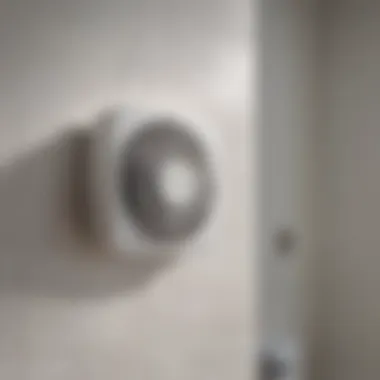
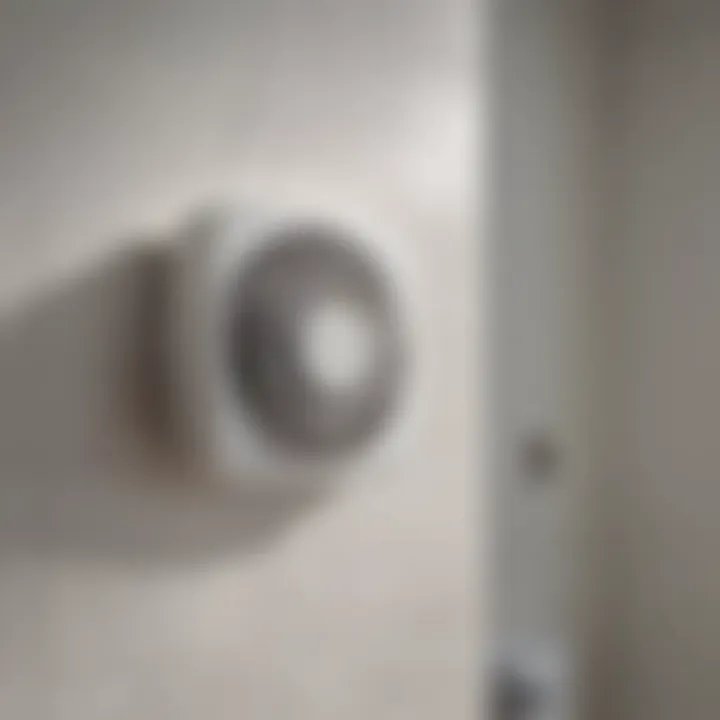
Choosing a silent bathroom fan involves understanding several key features. They directly influence how well the fan performs in a space that often harbors moisture and odor. Thus, awareness of these aspects can help consumers make informed decisions.
CFM Rating and Airflow
CFM, or Cubic Feet per Minute, measures the airflow produced by a bathroom fan. A higher CFM rating indicates a greater ability to move air. It's essential to match the fan's CFM output to the size of your bathroom for effective ventilation. As a general guideline:
- Small bathrooms (up to 50 sq ft): 50 CFM
- Medium bathrooms (50 to 100 sq ft): 100 CFM
- Large bathrooms (over 100 sq ft): 150 CFM and above
By ensuring the fan has the appropriate CFM rating, owners can prevent excess humidity, mold growth, and undesirable odors in their bathrooms.
Energy Efficiency Ratings
Energy efficiency is a crucial consideration, especially for households focused on reducing utility costs. Fans come with Energy Star ratings to indicate how efficiently they operate. Investing in an Energy Star-certified fan generally ensures lower operating costs. The mark signifies that the product meets strict energy efficiency criteria, promoting sustainability.
Alongside lower energy consumption, these fans often function as silently as they do effectively. Therefore, in addition to saving, homeowners also contribute to environmental welfare.
Noise Levels and Their Implications
Noise levels are a significant concern for many bathroom users. Measured in sones, the right fan should operate quietly in the background. Generally, a fan rated at 1.0 sones or less is considered quiet, while 2.0 sones can be acceptable to some but might be disturbing in tight spaces.
Reducing noise during operation contributes generally to a more comfortable and peaceful bathroom environment. Surfaces such as tile amplify sound, so a silent fan can help mitigate that problem.
Top Silent Bathroom Fan Recommendations
Choosing the right silent bathroom fan can greatly impact the overall comfort and functionality of your bathroom. Not only do these fans work to eliminate moisture and odors, but they also contribute significantly to energy efficiency and a quieter home environment. The proper selection will depend on both your budget and specific needs, whether it's enhancing airflow, aesthetic appeal, or ease of installation.
High-Efficiency Models
High-efficiency bathroom fans utilize advanced technology to provide excellent airflow without consuming excessive energy. These systems often feature variable-speed motors, allowing them to adapt their performance to your specific requirements. One noteworthy advantage is the potential savings on energy bills in the long run. Look for models that have Energy Star ratings, as these are designed to meet strict efficiency guidelines. Additionally, fans like the Broan-NuTone SPK110SIL blend functionality with modern design and might include integrated lighting, offering both air circulation and illumination together.
Installation involves standard wiring processes. Ensure the fan is appropriately calibrated to fit vent size, as mismatch can reduce overall efficiency.
Affordable Options Worth Considering
Selecting series categorized as budget-friendly doesn’t mean compromising on performance. Several manufacturers provide cost-effective options realizing not all homeowners want to forgo setup simplicity for savings. Models such as Panasonic FV-05-11VK1 exhibit a good balance between affordability and necessary features. Look for units that maintain satisfactory noise ratings while still achieving optimal airflow.
Remember, even lower-priced fans have varying price points which relate to construction quality. Shopping during off-peak seasons can also yield discounts. Understand the installation ease to perform the task yourself or plan to bring in experts are an important consideration.
Premium Brands and Their Offerings
When opting for premium bathroom fans, the focus often shifts from basic functionality to superior design and features. Brands like Delta Breez SLM70 ensure that owners experience both performance and aesthetics, seamlessly integrating with contemporary bathroom interiors. Often premium models introduce additional features such as dual installations ranging from ceiling and wall-mounted options to LED lighting and motion sensors that switch the fan on when someone enters the room.
Advanced materials are used in construction, providing durability against moisture effects. Customers frequently enjoy a wider spectrum of visual appeal and customization when considering premeium options. Check manufacturer websites for detailed performance ratings and customer support, which often are underexploited benefits of choosing premium models.
The right fan will ensure that the air in your bathroom remains fresh and free of unpleasant odors, creating a comfortable experience every time you step in.
As consumer preferences evolve, manufacturers are continually refining their products to cater to diverse market dynamics. Understanding the tradeoffs between price, efficiency, and added perks will guide you in making an informed decisio. Investing in a bathroom fan is not just a home improvement task but a choice benefiting your long-term comfort and satisfaction.
Installation Considerations
When selecting a bathroom fan, installation is a critical step that can impact the overall function of the unit. Ensuring the proper setup maximizes airflow and minimizes noise, contributing to an effective, silent bathroom environment. Effective installation also prevents future maintenance issues. There's also the potential for increased energy efficiency when the fan is installed correctly. A poorly installed fan may not perform as well, reducing its lifespan and effectiveness.
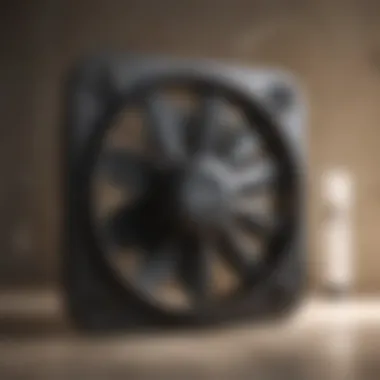
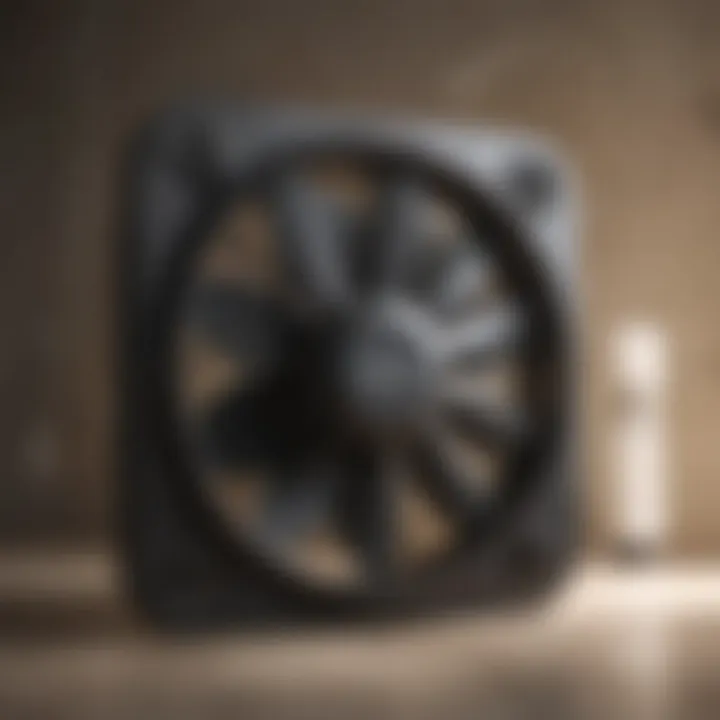
Proper Placement for Optimal Performance
Effective placement is crucial when installing a silent bathroom fan. The fan should be positioned for optimal airflow; it typically requires placement near the source of humidity, which is often over the shower or bathtub. Installing the fan too far from these areas will lessen its ability to remove moist air efficiently. This placement also reduces the chances of mold and mildew buildup, which can seriously affect the aesthetic and health of your bathroom.
Here are some considerations to keep in mind:
- Height: Installing the fan at a height that does not interfere with regular use.
- Distance: Keep walls or other obstructions away that might hinder airflow.
- Duct Alignment: Ensure straight and smooth duct runs for the best ventilation results.
DIY Installation Tips
Installing a bathroom fan can be a straightforward task for a confident DIYer. However, there are crucial steps to follow to ensure success. Below are some practical tips:
- Read the Manual: Each unit comes with specific instructions. Having a clear guideline will prevent mistakes.
- Gather Tools: Standard tools often needed include a drill, screwdriver, and duct tape.
- Safety First: Ensure the power is turned off before starting any electrical work.
- Secure Ventilation Channels: Use aluminum ducting for creating ventilation paths because it stays cool and reduces noise.
- Test before Sealing: Once installed, power the fan on before closing everything permanently to ensure it runs smoothly and quietly.
When to Hire a Professional
While some homeowners may feel confident in their ability to install a bathroom fan, certain circumstances indicate that hiring a professional is the best course of action. Rather than risk functionality or safety, consider the following scenarios:
- Electrical Work: If the installation requires new wiring or if you're uncomfortable with electrical tasks.
- Structural Concerns: Involving into areas requiring modifications to the ceiling or walls.
- Complex Duct Placement: If the venting setup requires navigating multiple bends or connecting to existing ventilation systems.
Ultimately, engaging with a professional will ensure the bathroom fan is installed with precision, maintaining effectiveness and safety for your home.
Maintenance and Care
Maintenance and care are essential elements to ensure a silent bathroom fan operates at its best. This regular upkeep protects the investment you made in purchasing a good fan and prevents potential problems from developing over time. Keeping the fan clean boosts its efficiency, extends its lifespan, and minimizes noise levels. For housewives and homeowners, maintaining the fan aligns with the broader objective of having a comfortable and pleasant living space.
When you ensure your bathroom fan is well cared for, you also improve air quality in the home. Dust, moisture, and mold can accumulate in or around the fan if maintenance is neglected. Proper maintenance can mitigate these concerns, fostering a healthy environment. Understanding the few simple steps involved can make the task less daunting.
Cleaning the Fan: Best Practicse
Regular cleaning is crucial for maintaining your silent bathroom fan. It helps in ensuring that that airflow is unimpeded. Here are some best practices:
- Unplug and Onnect: Always turn off the power to the fan before cleaning. Remove the cover to access the blades without complications.
- Trap Time: Use a vacuum attachment to remove dust and debris. Cleaning these parts will promote better airflow.
- Gentle Wipe: Use a damp cloth to wipe blades carefully, avoiding aggressive scrubbing which could damage the unit.
- Cover Place: Clean and dry the cover before reattaching. Check that there is no buildup on any parts.
- Schedule Regular Cleaning: Aim for cleaning the fan every six to twelve months, depending on usage.
It is essential to keep in mind that neglecting your bathroom fan can lead to reduced efficiency and potentially increased energy costs over time.
Troubleshooting Common Issues
Even a well-maintained silent bathroom fan can face issues occasionally. Knowing how to troubleshoot effectively is invaluable. Here are some common problems and helpful solutions:
- Noisy Operation: If your usually quiet fan has become noticeably loud, check if any dust or debris is obstructing the blades. Tightening any loose parts is critical as well.
- Inadequate Airflow: Insufficient airflow might result from an obstruction. Ensure no items like towels are blocking the fan's inlet.
- Fan Won’t Start: If the fan fails to start, double-check that it is properly connected and powered on. You might wish to test the unit on another circuit.
- Flickering or No Light: If your fan has integrated lighting and it's malfunctioning, replace the bulb. In some cases, wiring issues could require a professional to inspect.
- Stuck or Frozen Blades: Lubricate the motor and fan blades if they appear stuck. Use a light machine oil for this procedure.
In implementing these practices and understanding common issues, homeowners can maintain their bathroom fan efficiently and effectively.
Culmination
Choosing the right silent bathroom fan is an important decision that can significantly affect both the functionality and comfort of your space. Throughout this article, we have explored multiple facets that contribute to selecting the ideal fan. This includes understanding noise ratings, determining the necessary airflow capacity, and recognizing the importance of energy efficiency.
Making the Right Choice
When you think about the investment in a bathroom fan, it is crucial to focus on quality and performance. Look for the CFM rating to ensure adequate airflow. Your choice should also consider the installation process. Proper placement ensures that the fan performs optimally in removing moist air. Furthermore, evaluating features, such as integrated lighting, can enhance your bathroom's overall usability. The price of the fan is another point to ponder. It’s not just about the lowest cost, but what are you getting in value. A more efficient model might save you money in the long run through reduced utility bills.
The Impact of a Good Fan on Your Bathroom
A high-quality bathroom fan plays a vital role in maintaining a comfortable environment. Efficient ventilation prevents mold and moisture buildup, which can lead to expensive repairs down the line. Moreover, a good fan maintains air quality by reducing humidity levels and circulation. By mitigating these concerns, not only does the fan serve a functional purpose, but it also enhances the overall ambiance. Bathrooms becoming a pleasant space rather than just utilitarian zones.
“A quality fan will keep your bathroom dry and comfortable, benefiting both the structure and the people who use it.”
In summary, investing in an excellent silent bathroom fan is not just about aesthetics or reduced noise; it tangibly improves your bathroom's environment. After considering installation, maintenance, and your family's unique needs, you can confidently select a fan that serves your home well. Making the right choice guarantees satisfaction and functionality, which are essential for any homeowner.







